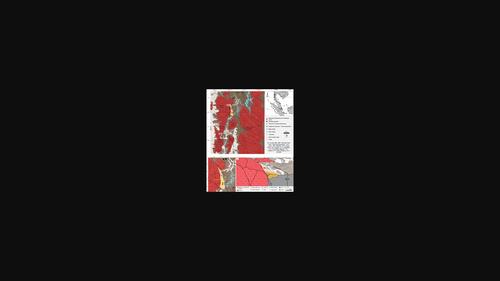当前位置:
X-MOL 学术
›
Geolog. J.
›
论文详情
Our official English website, www.x-mol.net, welcomes your feedback! (Note: you will need to create a separate account there.)
Structural and palynomorph evidence for Early Palaeogene-Neogene conglomerate series in Peninsular Malaysia: Implication for basin development and tectonic history
Geological Journal ( IF 1.8 ) Pub Date : 2022-08-14 , DOI: 10.1002/gj.4556 Noor Liana Mahmud 1 , Benjamin Sautter 1, 2
Geological Journal ( IF 1.8 ) Pub Date : 2022-08-14 , DOI: 10.1002/gj.4556 Noor Liana Mahmud 1 , Benjamin Sautter 1, 2
Affiliation

|
Rifting initiation and development in Western Sundaland is spectacularly synchronous and diffuse spatially, with only one exception, the Malay Peninsula that appears as a large crustal horst, weakly deformed and thus isolated from the presently offshore stretched crust. Cenozoic stratigraphic records are limited onshore, with only isolated conglomeratic series that are keys to integrating the Malay Peninsula in the regional chronology of events. This study focuses on the Lawin and Chenderoh conglomeratic series, located in the Perak Valley, Peninsular Malaysia, that were previously interpreted as Late Tertiary to Quaternary in age, albeit without proper basin analysis and/or geochronological data. Through a GIS-based kinematic analysis, we investigate the deformation affecting the basement rocks, while a field-based study and palynomorph analysis were used to constrain the tectonic framework at the time of deposition of each conglomeratic series. Our findings reveal that the Lawin alluvial fan was deposited during an episode of E–W extension controlled by a N–S normal fault. The fan evolved from debris flow to sheet flooding depositional stages. The palynomorph study suggests a burial from the Pliocene onwards (<5 Ma) but older series are suspected at depth. From the Oligocene Chenderoh shale unit, a Miocene age of the conglomeratic series is inferred. Chenderoh conglomerate is believed to have developed within pre-existing isolated depressions formed during regional transtensional events. Our study reveals that the Malay Peninsula was indeed affected by extension in the Late Palaeogene-Early Neogene, but with low rates of subsidence as compared to rapidly subsiding offshore basins.
中文翻译:

马来西亚半岛早期古近纪-新近纪砾岩系列的构造和孢粉型证据:对盆地发育和构造历史的启示
西巽他兰的裂谷开始和发展在空间上是惊人的同步和扩散的,只有一个例外,马来半岛表现为一个巨大的地壳垒,变形较弱,因此与目前近海伸展的地壳隔离开来。新生代地层记录在陆上是有限的,只有孤立的砾岩系列是将马来半岛纳入区域事件年表的关键。这项研究的重点是位于马来西亚半岛霹雳河谷的 Lawin 和 Chenderoh 砾岩系列,尽管没有适当的盆地分析和/或地质年代学数据,但以前被解释为晚第三纪至第四纪。通过基于 GIS 的运动学分析,我们研究了影响基底岩石的变形,而基于实地的研究和孢粉形分析被用来限制每个砾岩系列沉积时的构造框架。我们的研究结果表明,Lawin 冲积扇是在由 N-S 正断层控制的东西向伸展事件中沉积的。扇由泥石流沉积阶段演变为片状驱沉积阶段。孢粉形研究表明从上新世(<5 Ma)开始埋葬,但在深度怀疑较早的系列。从渐新世 Chenderoh 页岩单元,推断出砾岩系列的中新世时代。Chenderoh 砾岩被认为是在区域跨张事件期间形成的预先存在的孤立凹陷中发展的。我们的研究表明,马来半岛确实受到古近纪晚期-新近纪早期伸展的影响,
更新日期:2022-08-14
中文翻译:

马来西亚半岛早期古近纪-新近纪砾岩系列的构造和孢粉型证据:对盆地发育和构造历史的启示
西巽他兰的裂谷开始和发展在空间上是惊人的同步和扩散的,只有一个例外,马来半岛表现为一个巨大的地壳垒,变形较弱,因此与目前近海伸展的地壳隔离开来。新生代地层记录在陆上是有限的,只有孤立的砾岩系列是将马来半岛纳入区域事件年表的关键。这项研究的重点是位于马来西亚半岛霹雳河谷的 Lawin 和 Chenderoh 砾岩系列,尽管没有适当的盆地分析和/或地质年代学数据,但以前被解释为晚第三纪至第四纪。通过基于 GIS 的运动学分析,我们研究了影响基底岩石的变形,而基于实地的研究和孢粉形分析被用来限制每个砾岩系列沉积时的构造框架。我们的研究结果表明,Lawin 冲积扇是在由 N-S 正断层控制的东西向伸展事件中沉积的。扇由泥石流沉积阶段演变为片状驱沉积阶段。孢粉形研究表明从上新世(<5 Ma)开始埋葬,但在深度怀疑较早的系列。从渐新世 Chenderoh 页岩单元,推断出砾岩系列的中新世时代。Chenderoh 砾岩被认为是在区域跨张事件期间形成的预先存在的孤立凹陷中发展的。我们的研究表明,马来半岛确实受到古近纪晚期-新近纪早期伸展的影响,



























 京公网安备 11010802027423号
京公网安备 11010802027423号